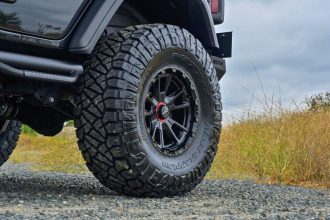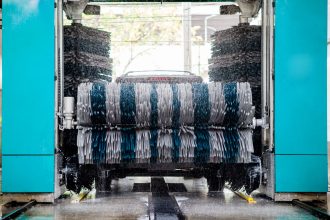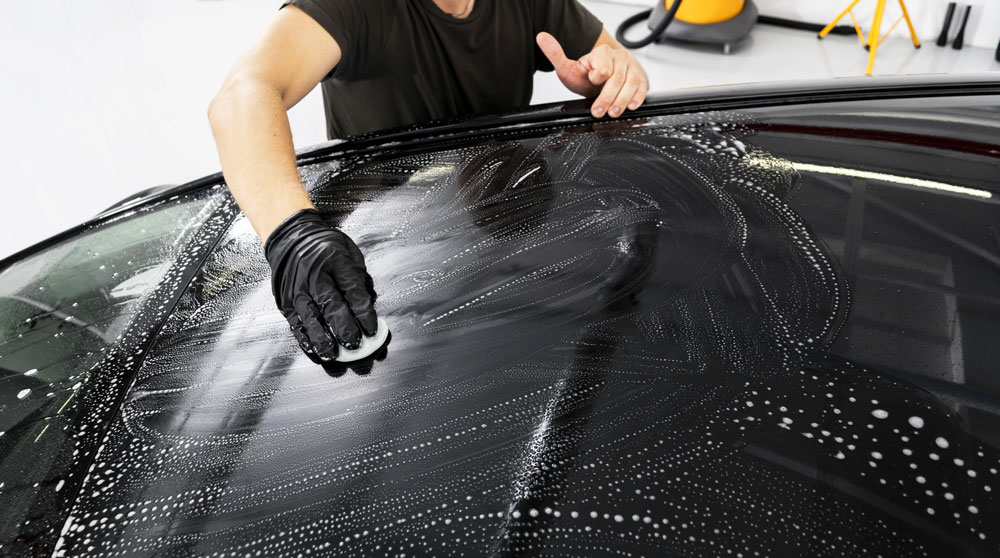
Rubbing clay back and forth on your car’s finish may sound crazy. However, detailing clay is one of the most effective ways to remove surface contaminants from your car’s finish – we’ll show you how to clay bar your car step-by-step. These bars extract debris that’s embedded in the paint, beyond what compounds and polishes can achieve. The results are a silky smooth finish that’s ready to be followed by a polish and/or wax.
We recommend the Mothers California Gold Clay Bar System as our top pick. Mothers has been in the detailing clay game forever and their clay bar kit just plain works. It comes with everything you need to tackle several cars, including a microfiber towel and lubricant.
The Mothers kit is great, but we also recommend several others. We’ll cover each kit, along with an in-depth guide on how to clay bar your car.
Contents
The Best Clay Bar Kits in 2023
 1 – Mothers California Gold Clay Bar System
1 – Mothers California Gold Clay Bar System
The Mothers clay bar kit gets the job done right the first time. The formula seems just right. It’s strong enough to handle almost all rough finishes, but not too abrasive to harm your paint. It leaves hardly any streaks when used correctly. Plus, it’s malleable and easy to knead. It comes with two 100 gram bars, their quick detail spray, and one microfiber towel. You could easily use your own favorite lubricant instead, but the Mothers detail spray was just fine.
The added microfiber towel is something the other kits don’t offer, making this one of the best kits for the money.
2 – Chemical Guys Light Duty Clay Bar
The team at Chemical Guys has their own clay bar kit. This one comes with one 100 gram clay bar, plus a bottle of their wetting agent. It’s safe on older paint and works great to remove those pesky metal particles. It’s also great on new finishes as well and gentle on your clear coat. The performance of the Chemical Guys clay bar is well above average, leaving your finish as smooth as glass.
Their ‘super lube’ is good, but if you run out, don’t worry. You easily use your favorite quick detailer if needed.
3 – Griot’s Garage Paint Cleaning Clay Kit
The Griot’s Garage Cleaning Clay Kit will lift away surface debris quickly and easily. Its performance is on par with Chemical Guys, however Griot’s claims that their clay won’t strip away wax. This may be important for some, but we’d still recommend following up with a polish, if needed, then wax afterwards.
Griots comes with massive 226 gram bar, large enough to divide into halves. The kit also comes with their famous Speed Shine, one of our favorite detail sprays on the market. Count on Griot’s kit to create an ultra-smooth and clean surface.
4 – Meguiar’s Smooth Surface XL Clay Kit
Meguiar’s clay bar kit exceeded our high expectations. First, similar to the Mothers kit, the Meguiar’s clay kit comes with everything you’ll need. Included are two 80 gram clay bars, a bottle of their quick detailer, and great microfiber towel.
The clay’s performance gets high marks. There seemed to be a little less effort needed with this bar, helping to speed up the process. Be sure to check this one out, it won’t disappoint.
5 – Adam’s Fine Grade Clay Bar Kit
The clay kit from the Adam’s crew is safe for all paint finishes. It’s the least abrasive in their line up, but still gets the job done. Two 100 gram bars are included, plus their well-known detail spray as lubricant. This one seems a little softer than others, yet performs great. Paint is left silky soft and ready for waxing.
What is a Clay Bar?
During the 1990s, an innovative method for eliminating paint contaminants emerged in the automotive industry: the use of automotive detailing clay. Initially, this technique was primarily employed to address the issue of paint overspray. However, it soon became evident that automotive detailing clay possessed the ability to effectively remove various other types of contaminants as well.
When using automotive detailing clay, the process involves gently rubbing the clay over the vehicle’s paint surface while employing a lubricant. This technique can be compared to running a razor over the skin to remove unwanted hairs. As the clay glides back and forth, it sheers and picks up foreign particles from the surface, effortlessly restoring its original appearance. The clay’s inherent stickiness plays a crucial role in collecting these particles, making it easier to remove them. To facilitate this stickiness, a lubricant or quick detailer is used throughout the entire process.
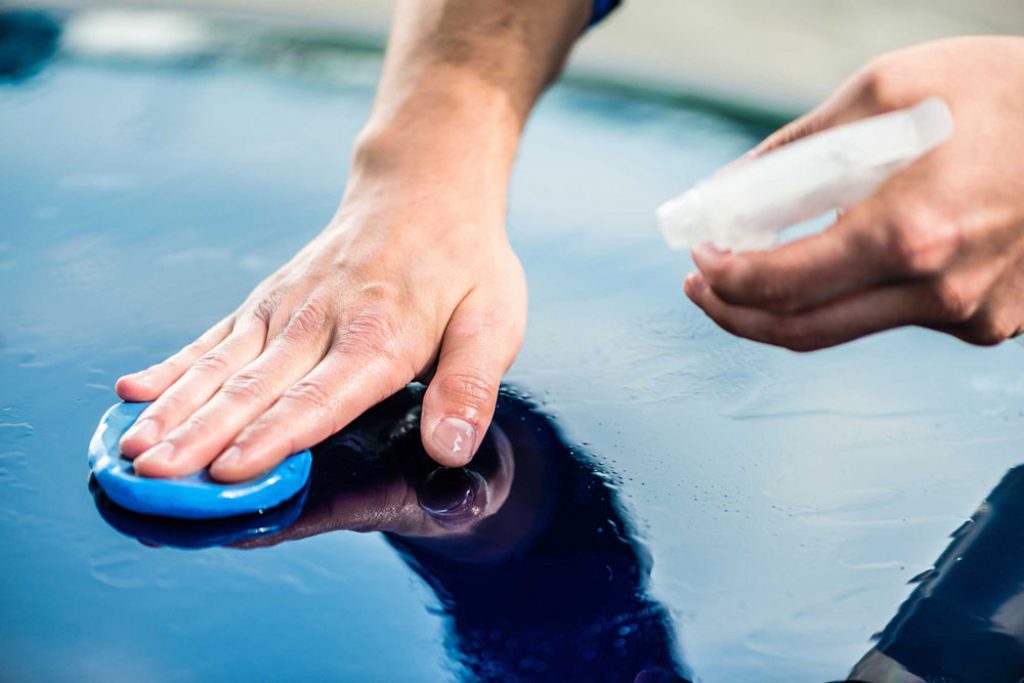
Clay bars used in automotive detailing are available in different varieties, with variations in their composition. They can be made from natural ingredients, synthetic materials, or a combination of both. However, most clay bars on the market today are resin-based and derived from synthetics. This resin-based formulation ensures optimal performance and durability.
Clay bars are manufactured in various sizes, measured in grams, such as 100 or 200 grams. Additionally, clay bars come in different grades, each with its own level of aggressiveness. Some clay bars are more aggressive, designed for tackling stubborn contaminants, while others are more gentle, suitable for general use. Most clay bars available to consumers fall into the mild category, effectively removing a wide range of contaminants and particles.
All clay bars possess a pliable nature, allowing them to be easily reshaped according to specific needs. While clay bars typically come in block or brick form, professional detailers often mold them into smaller, flatter disks that are more manageable during the detailing process.
When to Clay Bar your Car
To assess whether your car requires a clay bar treatment, there’s a simple test you can perform, known as the plastic bag test. If your vehicle is more than a few years old, follow these steps: After washing your car, head to the kitchen and grab a small resealable plastic sandwich bag. Cover your hand with the bag and run your fingers along the hood of your car. You’ll likely be taken aback by the roughness you feel. Despite the surface appearing smooth after a fresh wash, the texture is entirely different to the touch. This roughness indicates the presence of surface contaminants that have bonded with the paint.
Understanding the Causes of a Rough and Gritty Surface
Numerous factors contribute to the rough and gritty surface of your car’s paint. When driving on the road, your vehicle inevitably collects various unsightly particles that become embedded within the paint over time. Brake dust and tree sap are among the many examples of contaminants that can mar your car’s appearance. Even leaving your car unwashed for an extended period can have detrimental effects. These particles accumulate gradually, and no amount of regular washing or polishing can fully eliminate them.
The Effective Solution: Using a Clay Bar Kit
To effectively eliminate the debris and restore a smooth finish, the proper use of a clay bar kit is highly recommended. This kit provides you with the necessary tools to remove the embedded contaminants, leaving your car’s paint surface rejuvenated. The process involves gently rubbing the clay bar over the affected areas, allowing the bar’s sticky texture to pick up and remove the bonded particles. By employing this technique, you can achieve a fresh, smooth finish that will enhance the overall appearance of your vehicle.
Accessible for Everyone, Not Just The Pros:
One of the best aspects of clay bar treatment is that it is not limited to automotive professionals. Anyone can learn and apply this technique to their vehicle. With the availability of clay bar kits and the proper guidance, car owners can successfully perform this procedure themselves. You don’t need specialized training or expertise to achieve impressive results. By investing a little time and effort, you can enjoy the benefits of a meticulously cleaned and rejuvenated paint surface.
How to Clay Bar your Car – (Simple Steps)
The Auto Care Geek Team has developed an in-depth guide on how to clay bar your car. Follow the steps below to safely achieve a silky smooth finish for your car’s paint.
Step 1 – Wash you ride
Fully wash your car using the two bucket method. It’s important to learn how to wash your car by hand to avoid scratches.
Step 2 – Shape the detail clay
Wet the clay bar while kneading it slowly, working to flatten it gently into a disk
Step 3 – Spray quick detailer
Start with a small section and spray the lclay bar ubricant or quick detailer spray, fully wetting the paint and the bar
Step 4 – Work the clay
Begin lightly moving the bar back and forth on the paint. Don’t use circular motions. Use straight line motions only
Step 5 – Check for resistance
Continue guiding the bar over the surface, using more lubricant if you encounter resistance
Step 6 – Smooth as ice
Once the clay bar can easily glide over the surface, you’re ready to move on
Step 7 – Wipe down
Wide down the area with a microfiber towel and begin the next section
How to Clay Bar your Car (Detailed Guide 2023)
Before starting the clay bar process, ensure that your car’s paint is clean. We highly recommend giving your vehicle a thorough wash to remove any dirt and grime. This step is crucial in minimizing the risk of damaging your car’s clear coat.
Set aside at least an hour or two to complete the task for your entire car. Keep in mind that this is a significant step that typically needs to be done only once a year or so, depending on various factors. Taking your time is essential. Additionally, it’s advisable to work in the shade as it will help keep your paint cool and allow the spray detailer to last longer.
To get started, gather three basic items: a clay bar, clay bar lubricant or spray detailer, and several microfiber towels. The clay bar will effectively pull particles from the paint, while the spray detailer keeps the surface wet, which is crucial throughout the process. If you’re interested in learning more about detail sprays, you can check out our review on the best options. Lastly, have the microfiber towels on hand to help wipe down the surface as you progress.
Begin by working on small sections at a time. Spray a generous amount of clay bar lubricant onto the paint surface. This liquid will prevent the detailing clay from sticking to the paint. Make sure to wet the clay as well. Gently flatten the bar by slowly kneading it. Then, start gliding it back and forth over the paint, maintaining a steady and straight motion while avoiding circular movements.
As you work, try not to exert excessive force. Allow the clay bar to do its job. If you encounter resistance, simply spray more lubricant and repeat the process. You’ll know you’re finished with a section when the clay bar glides effortlessly over the paint without encountering any rough patches. Then, move on to the next area.
Keep a close eye on the color of the clay bar. It will pick up tiny metal particles during the process, which may cause it to turn slightly grey or brown. To prevent these contaminants from scratching the surface, gently fold and knead the clay bar. Additionally, be cautious not to drop it on the ground. Regardless of how clean your garage floor may be, once the clay bar touches the ground, it becomes compromised. It will pick up debris from the floor, which can easily scratch your car’s finish.
Once you’ve completed the clay bar treatment, store any remaining unused pieces in a resealable plastic bag. To finish up, wipe down the paint using a bit more detail spray along with the microfiber towels. Voila! You’re all set. You’ve successfully taken a crucial step in cleaning and restoring your car’s finish, leaving it looking refreshed and revitalized.
Remember, your car’s finish is unprotected as you’ve stripped away all surface contaminants. Apply one of the best carnauba waxes or best car paint sealants as soon as possible.
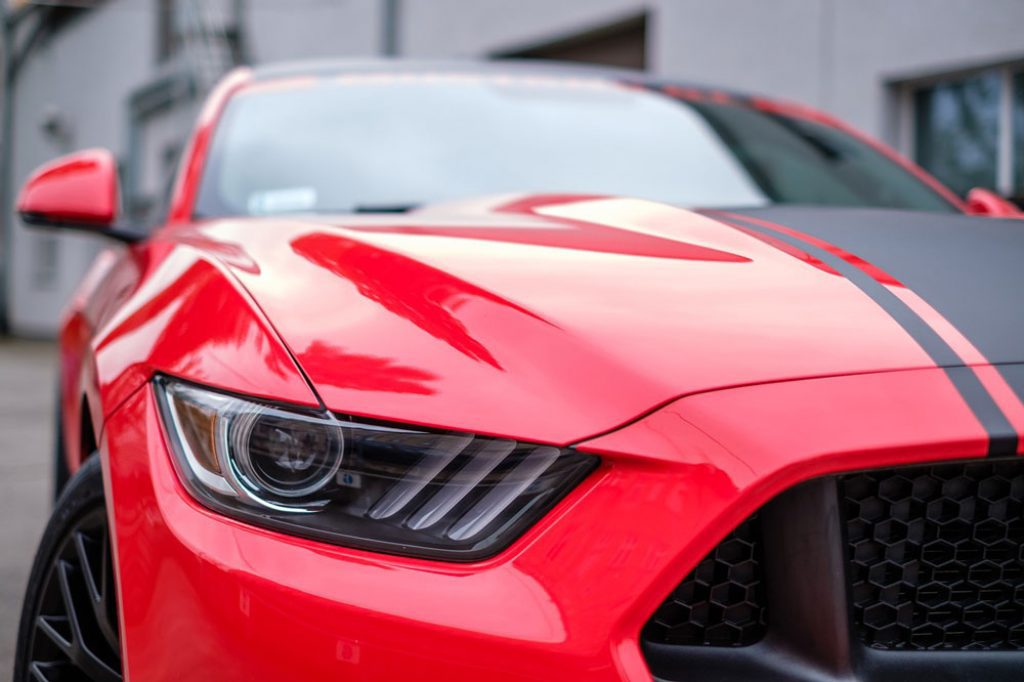
Clay Bar FAQs
What is a clay bar, and what is its purpose?
A clay bar is a malleable tool used in automotive detailing to remove embedded contaminants from a car’s paint surface. It effectively removes particles such as brake dust, tree sap, industrial fallout, and other stubborn substances that regular washing cannot eliminate.
Example: Imagine you parked your car under a tree, and as a result, it got covered in sticky tree sap. A clay bar would be an ideal solution to remove that stubborn sap and restore the smoothness of your car’s paint.
How does a clay bar work?
Clay bars work through a combination of mechanical and adhesive action. When lubricated with a detailing spray or clay lubricant, the clay bar glides over the paint surface, picking up and trapping contaminants. The sticky nature of the clay helps pull the particles from the paint, leaving a clean and smooth finish.
Example: If you’ve noticed roughness on your car’s surface even after washing it, that’s an indication of bonded contaminants. Using a clay bar will gently remove those contaminants, making your paint feel as smooth as glass.
Can clay bars damage my car’s paint?
When used correctly and with proper lubrication, clay bars do not damage car paint. The clay bar is designed to be gentle on the surface while effectively removing contaminants. However, if excessive force is applied or if the bar is dropped and picks up debris, it can potentially cause scratches. Always follow the instructions and use sufficient lubrication to minimize the risk of damage.
Example: Let’s say your car has a layer of industrial fallout from being parked near a construction site. By using a clay bar with care and attention, you can safely remove the embedded particles without causing any harm to the paint.
How often should I clay bar my car?
The frequency of clay bar treatments depends on various factors such as driving conditions, parking environment, and maintenance routine. As a general guideline, performing a clay bar treatment once or twice a year is usually sufficient for most car owners. However, if you frequently encounter harsh contaminants or notice roughness on the paint, more frequent clay bar treatments may be necessary.
Example: If you regularly drive in urban areas with heavy traffic and pollutants, you might find it beneficial to clay bar your car every six months to maintain a smooth and clean surface.
Can I use a clay bar on any part of my car?
Clay bars can be used on most exterior surfaces of a car, including the paint, glass, and metal. However, it is essential to avoid using a clay bar on rough or textured surfaces, matte finishes, or surfaces with chipped or damaged paint. Always refer to the manufacturer’s instructions and exercise caution when using a clay bar.
Example: You can safely use a clay bar to remove contaminants from your car’s windows, leaving them crystal clear for improved visibility during your daily commute.
Do I need any additional products besides the clay bar?
To effectively use a clay bar, you will need a clay lubricant or detailing spray to provide the necessary lubrication for the clay to glide smoothly over the paint surface. Additionally, having several microfiber towels on hand will help in wiping down the surface as you work.
Example: When working on your car, apply a clay lubricant generously to ensure a smooth and efficient process. This lubricant reduces friction, allowing the clay bar to pick up contaminants effortlessly.
Can I reuse a clay bar?
Clay bars can be reused multiple times, depending on the amount of contamination they pick up during each use. As the clay bar becomes saturated with contaminants, simply knead and fold it to expose a fresh surface. However, once the clay bar becomes too dirty or begins to crumble, it should be discarded and replaced.
Example: Imagine you’ve used a clay bar to remove the iron particles from your car’s paint. Afterward, you can inspect the clay bar, fold it to a clean section, and continue using it until it becomes ineffective in picking up more contaminants.
Can I clay bar my car if it has been recently polished or waxed?
It is generally recommended to clay bar your car before applying any polish or wax. The purpose of a clay bar treatment is to prepare the paint surface by removing contaminants and creating a smooth canvas for subsequent detailing steps. Performing the clay bar treatment first ensures maximum effectiveness of polishing and waxing processes.
Can I clay bar a brand new car?
Yes, even brand new cars can benefit from a clay bar treatment. Despite being new, they can accumulate contaminants during transportation, storage, or even at the dealership. A clay bar will ensure a truly clean and smooth surface.
Example: Your newly purchased car might have picked up industrial fallout during transportation. Using a clay bar will remove these contaminants and give your brand new car a pristine finish.
Can I clay bar a car with matte paint?
No, clay bars should not be used on surfaces with matte paint finishes. Matte paint requires specific care, and using a clay bar can cause unwanted shine or gloss. It is best to consult with professionals who specialize in matte paint care for appropriate maintenance methods.
Example: If you own a car with a matte finish, it’s crucial to avoid using a clay bar and instead follow the recommended cleaning techniques provided by the manufacturer or seek advice from experts in matte paint care.
Can a clay bar remove scratches?
No, clay bars are not designed to remove scratches. Their primary purpose is to remove embedded contaminants from the paint surface. While clay bars may improve the appearance of light surface scratches by removing contaminants around them, deeper scratches require other methods such as polishing or paint correction.
Example: If your car has minor scratches caused by light abrasions, using a clay bar may help reduce their visibility by eliminating contaminants that were exacerbating their appearance.
Can I clay bar my car in direct sunlight?
It is best to avoid clay bar treatments in direct sunlight. The heat can cause the lubricant to dry quickly, making the clay bar less effective and potentially leading to surface marring. Working in a shaded area or during cooler parts of the day will provide better conditions for a successful clay bar treatment.
Example: If you plan to clay bar your car, choose a time when your vehicle is shaded or find a covered area to prevent the clay from sticking and potentially causing damage to your car’s paint.
Can a clay bar remove water spots?
While clay bars can help improve the appearance of light water spots, they may not completely eliminate them. Water spots can sometimes etch into the paint, requiring more intensive polishing or paint correction methods. However, a clay bar can remove surface contaminants that contribute to the appearance of water spots.
Example: If your car has water spots caused by rain or sprinklers, using a clay bar may significantly reduce their visibility by removing the contaminants that were exacerbating their appearance.
Can I clay bar my car’s windows?
Yes, clay bars can be used on car windows to remove contaminants and achieve a smoother surface. However, be cautious when working on windows with tint or aftermarket coatings, as excessive pressure or improper technique may damage these delicate surfaces.
Example: If you notice a rough or gritty feel when running your fingers over your car’s windows, using a clay bar will help remove the embedded particles, providing a clear and smooth view.
Can I clay bar my car’s wheels?
Clay bars can be used on painted surfaces of car wheels to remove contaminants. However, avoid using them on bare metal or chrome surfaces, as clay bars can potentially scratch or damage these finishes. Instead, consider using specific wheel-cleaning products designed for different wheel types.
Example: If your car’s wheels have accumulated brake dust or other stubborn contaminants, using a clay bar can effectively remove them, restoring the wheels’ appearance.
Can I clay bar my car’s plastic trim or moldings?
While clay bars are primarily intended for use on painted surfaces, they can also be used on some plastic trim and moldings. However, it’s crucial to exercise caution and perform a small test spot first to ensure compatibility and avoid any potential discoloration or damage to the plastic. Different types of plastic may react differently to the clay bar, so it’s always recommended to test a small, inconspicuous area before proceeding with the entire surface.
Example: If you have plastic trim on your car that has accumulated contaminants and lost its luster, a clay bar can be used cautiously to remove the buildup and restore its appearance. However, be sure to test it on a small section first to ensure compatibility.
Can I clay bar a car with a ceramic coating or paint protection film (PPF)?
Clay bars can be used on cars with ceramic coatings or paint protection film, but it is important to follow the specific guidelines provided by the coating or film manufacturer. Some coatings or films may have specific recommendations for maintenance and surface preparation. Always consult the product documentation or seek advice from professionals to ensure proper care.
Example: If your car has a ceramic coating or paint protection film, a clay bar can still be used to remove contaminants. However, ensure that you follow the recommended instructions provided by the coating or film manufacturer to maintain the integrity of the protective layer.
Can I use dish soap as a clay bar lubricant?
Using dish soap as a clay bar lubricant is not recommended. Dish soaps are designed for dishwashing and can strip away wax, sealants, and other protective coatings on your car’s paint. It is best to use a dedicated clay bar lubricant or a spray detailer specifically formulated for automotive use.
Example: While washing your car, you may be tempted to use dish soap as a lubricant for the clay bar. However, using a proper clay bar lubricant will not only enhance the effectiveness of the clay bar but also maintain the protective layers on your car’s paint.
Can I clay bar a car with vinyl wrap or decals?
Clay bars should not be used on vinyl wraps or decals. The adhesive nature of the clay bar may cause damage or lifting of the vinyl or decals. Instead, use products specifically designed for maintaining and cleaning vinyl wraps or consult with professionals who specialize in vinyl wrap care.
Example: If your car has a vinyl wrap or decorative decals, it’s important to avoid using a clay bar on these surfaces to prevent any potential damage to the vinyl or decals.
Can I clay bar my car if it has been recently repainted?
Clay barring a recently repainted car is generally safe, as long as the paint has fully cured according to the manufacturer’s recommendations. However, it is advisable to consult with the body shop or painter who performed the repaint for specific guidance on when it is safe to clay bar the new paint.
Example: If you’ve recently had your car repainted to fix scratches or damage, ensure that the paint has fully cured before attempting to clay bar it. Consult with the professionals who performed the repaint for the appropriate waiting period.
Can I clay bar a convertible with a fabric top?
No, clay bars are not suitable for use on fabric convertible tops. The sticky nature of the clay can adhere to the fabric, causing staining or damage. Instead, refer to the manufacturer’s instructions for cleaning and maintaining fabric convertible tops, or consult with professionals who specialize in convertible top care.
Example: If you own a convertible with a fabric top, it’s important to follow the appropriate cleaning and maintenance methods recommended by the manufacturer to keep the top in optimal condition, avoiding the use of clay bars.
Sources:
- What is Clay? – Detailing Wiki
- What is Clay Lube – Detailing Wiki







